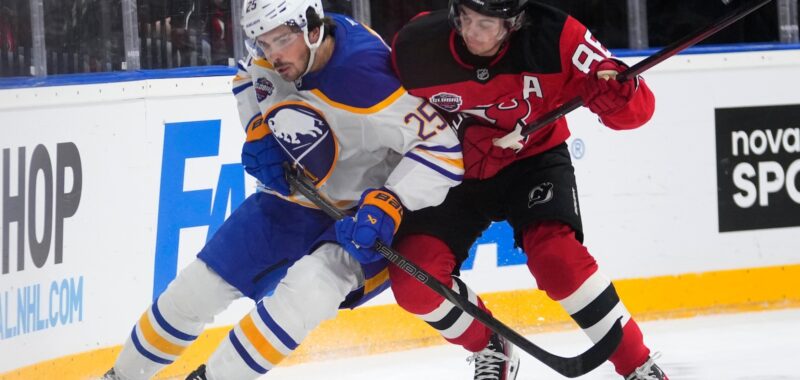DENVER — At first, the protective undershirt resembling a mock turtleneck was hot and uncomfortable. It even caused Jayson Megna’s visor to fog up.
But the journeyman hockey player stuck with wearing the long-sleeved base layer designed to protect his neck from a razor-sharp skate blade.
Since the death of Adam Johnson in October 2023 during a game in England, protective equipment has been a prime topic at every level of the sport. The American Hockey League, the top developmental league below the NHL, took a big step this season by requiring all skaters, referees and linespersons to wear some sort of cut-resistant neck protection.
Like the requirement of eye-protecting visors a decade ago, the neckwear could take some getting used to. It is becoming more common for players of all ages — Hockey Canada has mandated neck guard protection for youth players for three decades and USA Hockey made it mandatory for U.S. players under 18 as of Aug. 1 — and now all eyes are on the pros.
“Hopefully that’s what’s going to end up happening as we move forward here, that it’s just going to be a piece of their equipment,” said AHL president and CEO Scott Howson, whose league has long been a testing ground for the NHL, including 3-on-3 overtime and the mandate for cut-resistant socks and sleeves last season. “With the different products out there, hopefully all the players can find something that they can adapt to and eventually like — or, at the very least, not notice when they’re playing hockey.”
The death of Johnson was a horrific reminder of the risks. The former NHL player was cut in the neck during a game and died at a hospital. Guidelines exist for many youth programs in North America and beyond, but not at the highest levels of hockey, where league and players’ union leaders have discussed the topic for years.
Neck guards are getting a trial run in the AHL, which starts Friday, with unanimous backing from NHL executives on the competition committee.
“Last year some teams just decided, ‘Well, I can’t do it in the NHL, but I can do it in the American League,’” Howson explained. “We’ll see where it goes.”
The arguments against protective neckwear range from it being too hot to too restrictive to players simply being creatures of habit.
“Obviously, there’s things that people should do, but I think we’re stuck in our ways, also,” said New Jersey Devils forward Jack Hughes, who added he doesn’t wear nearly enough protective equipment. “Got to be comfortable.”
Longtime NHL player Pierre-Edouard Bellemare had planned on wearing a neck guard this season for the Colorado Avalanche before he was let go last week. He exalted the benefits of visors by pointing to the cuts in his beard that could’ve been worse if not for the eye protection.
Because on the ice, anything can happen.
“The game is faster and you have less control, sometimes to your body and the cutting all over the place is not something you want to see,” Bellemare said.
Bellemare simply wanted to pave the way for the next generation, like other players did before him with visors.
“It doesn’t cost me much” to wear protective neck gear, Bellemare said. “Come on, it’s a neck guard. That’s not going to change my season. I’m not going score 70 because I have a neck guard or not.”
Veteran defenseman Dylan McIlrath, who captained Hershey to back-to-back Calder Cup championships in the AHL, did not experiment with any neck protection during training camp in Washington and concedes players will endure some growing pains with the equipment. But the 32-year-old is not protesting too much.
“To be honest, I think it’s probably the right call,” McIlrath said. “Obviously it’s a younger league and the next generation coming up … guys can get used to it going into the NHL after playing in the American League a few years, they don’t really notice the changes.”
Megna, who was recently assigned to the AHL’s Colorado Eagles, has tried out different types of neck protection and brands. He’s been wearing one by T.J. Oshie’s Warroad Hockey Apparel that boasts “an adjustable neck collar built from premium grade cut resistant fabric and high-impact foam.” His undershirt has cut-proof sleeves.
Megna also wears cut-proof socks, which prevented a possible calf or Achilles injury last season when a player stepped on him with a skate blade.
“I could feel the skate there — felt like a burning sensation, and the protective sock saved me,” Megna said. “I didn’t even have a scratch. … Any time you can protect your players and increase safety, it’s a good thing.”
Megna said it didn’t take long to adjust to the new gear — maybe a session or two.
“After that, I haven’t even thought about it,” said Megna, who’s spent time with a half-dozen NHL organizations. “It’s just part of what I wear now.”
The NHL currently does not have any mandate that players must wear cut-resistant gear. That would require an agreement between the league and union.
St. Louis forward Robert Thomas understands the hesitation.
“For a lot of guys, it’s foreign, and you don’t want to change up what you’ve been doing your whole life,” Thomas said. “I think they’ve done a good job of having all that available to us. Some guys wear it, some guys don’t. I think giving guys the choice is ultimately the right decision.”
Eagles defenseman Jacob MacDonald anticipates that once he starts wearing the extra protection for his neck, it will become part of his routine — whether he’s in the AHL or called up to the NHL.
“I don’t have a crystal ball, but I think that it will definitely get more popular,” MacDonald said. “If it saves one life, it’s worth it.”
___
AP Sports Writer Mark Anderson and freelance writer W.G. Ramirez in Las Vegas contributed. Whyno reported from Arlington, Virginia.
___
AP NHL: https://apnews.com/hub/nhl

